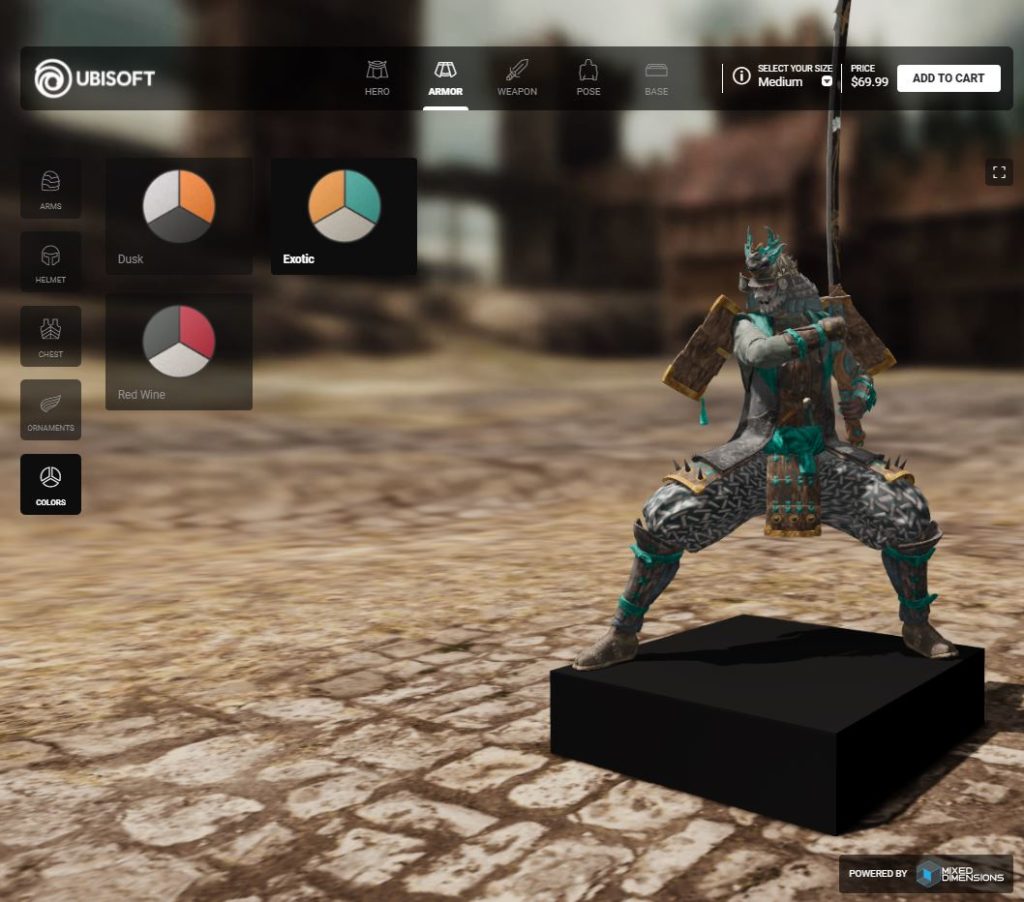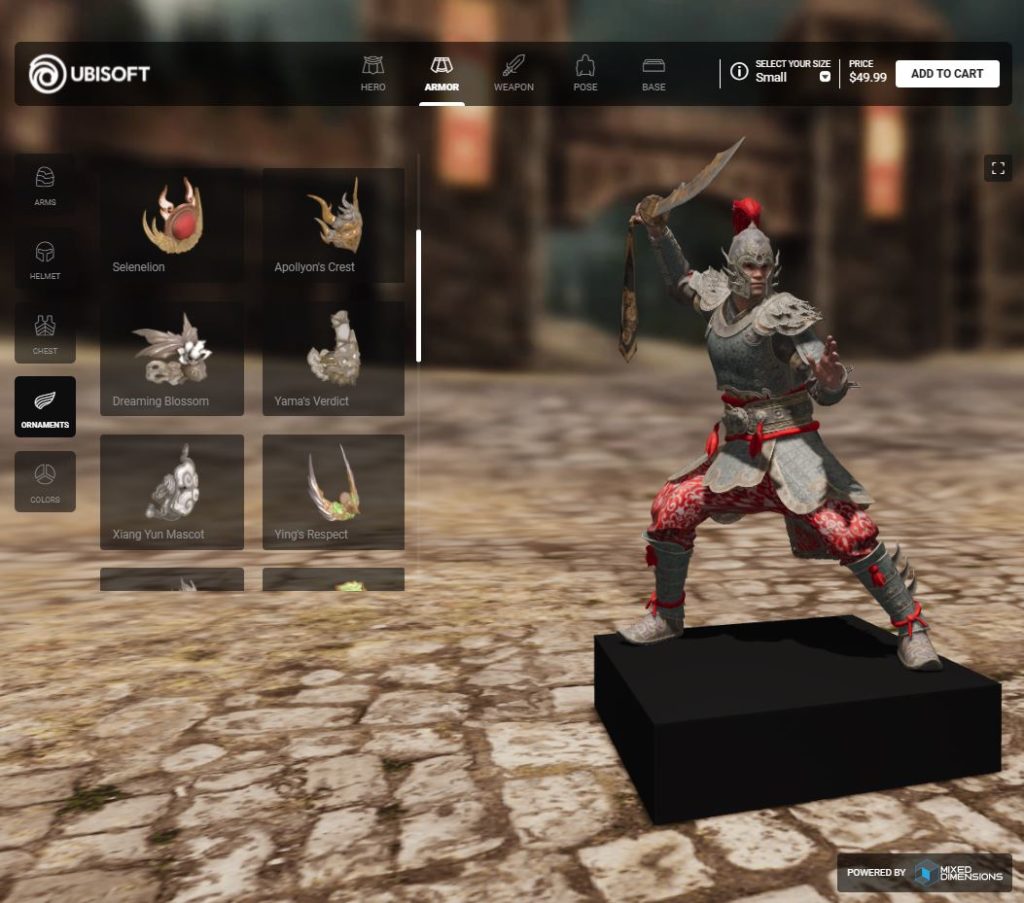Game giant Ubisoft will be offering 3D printed figurines to its game For Honor through Mixed Dimensions. For years, Jordanian and US-based Mixed Dimensions has worked at making in-game assets and figurines 3D printable. Connecting the virtual world with the real one is a huge potential business opportunity, as many millions of people play hundreds of hours in expansive digital worlds. Strong feelings and a connection to online worlds and characters mean that real-world mementos of digital moments are an exciting business opportunity. The nuts and bolts of making 3D markup 3D printable are complex, however, and Mixed Dimensions is alone in being able to tackle it.

Color is, famously, difficult for 3D printers to achieve and this has traditionally always been a stumbling block, as well. Mixed Dimensions solved this by turning to Mimaki 3D printers to make its colorful figures. Mimaki’s machines produce much brighter, shinier and vibrantly colorful objects than have traditionally been possible for us to do. This has given Mixed Dimensions a real boost. Mixed Dimensions is also able to now offer these figurines relatively inexpensively, starting at $24.99 and going up to $99.99 for their figurines.
Mixed Dimensions Chief creative officer Zuhair Abdul-Hadi said, “Building the ‘For Honor’ customizer is a dream coming true. The team and I are big fans of the game. The customizer was built by fans for fans. We can’t wait for gamers to hold these stunning figures in their hands!”
Jean Gauvin, Sr Creative Director at Ubisoft, said, “We have been working with Mixed Dimensions for the last two years to come up with a product of exceptional quality for our fans. Being able to bring to life your favorite customized character from For Honor was a vision we had from the get-go, and I have to say that building it in our customizer is a totally awesome experience!”
The figures can be ordered directly from Ubisoft here. Fans can choose the type of hero, pick their armor and weapons and select a pose, as well as a base.

Virtual goods alone account for more than $15 billion in revenue a year; online games themselves are set for revenues of over 23 billion. The whole game industry is worth $152 billion. Over 2.4 billion people played mobile games last year. The money sloshing around the games industry is huge. We’re used to thinking of 3D printing as the end-all-be-all, but we are tiny when compared to the total gaming industry. Something like this one project could become hugely successful just given the large number of players and interest in games.
We tend to focus on automotive adoption and things like orthopedics as major drivers of growth in 3D printing. Indeed, there is a lot of hope and possibility there. However, what about the giant opportunity in the consumer space? Apps and games are engaging and manage to bind millions of people to them each day. These games also have customization engines in them and use 3D markup to create engaging worlds. We are so incredibly adjacent and compatible that I really do believe that the immense opportunity in making everything in the virtual world printable is overlooked.
More than two billion people have a device in their hands that can manipulate and make interesting 3D markup. They can use this device to buy things immediately, as well. 3D printing can make things on demand. And what are we doing? Groveling for the same three guys at Volkswagen to get our parts made by them. What about a direct-to-consumer 3D printing proposition? Where are the direct-to-consumer customization startups? Where are the people using the fast-to-market, fast-to-failure nature of our technology to succeed in selling things? In cost, we’re unfortunate and the finish is also not often what the consumer wants, but with little up-front cost, direct-to-consumer propositions should be flourishing, but not a lot of people are attempting to succeed in this way.
I really think that what Mixed Dimensions is doing is very important to all of us. While we pour over ISO standards, someone has to be working on making our technology accessible to the billions of people in the world who wish to consume stuff. Yes, we’ve tried before through services and some startups, but with each product prototype costing a few to a $100 dollars, why don’t we just keep trying this until we win the 3D printing lottery and succeed?
Subscribe to Our Email Newsletter
Stay up-to-date on all the latest news from the 3D printing industry and receive information and offers from third party vendors.
Print Services
Upload your 3D Models and get them printed quickly and efficiently.
You May Also Like
Heating Up: 3D Systems’ Scott Green Discusses 3D Printing’s Potential in the Data Center Industry
The relentless rise of NVIDIA, the steadily increasing pledges of major private and public investments in national infrastructure projects around the world, and the general cultural obsession with AI have...
Formlabs Teams Up with DMG MORI in Japan
In late June, Nick Graham, Chief Revenue Officer at Formlabs, announced on LinkedIn that the company had partnered with DMG MORI, one of the world’s leading machine tool companies, to...
EOS in India: AM’s Rising Star
EOS is doubling down on India. With a growing base of aerospace startups, new government policies, and a massive engineering workforce, India is quickly becoming one of the most important...
3D Printing News Briefs, June 25, 2025: R&D Materials, 3D Printed Veneers, & More
In today’s 3D Printing News Briefs, 3DXTECH has launched a program that gives customers early access to experimental materials, and the first Lithoz CeraFab Multi 2M30 in the Czech Republic...



































